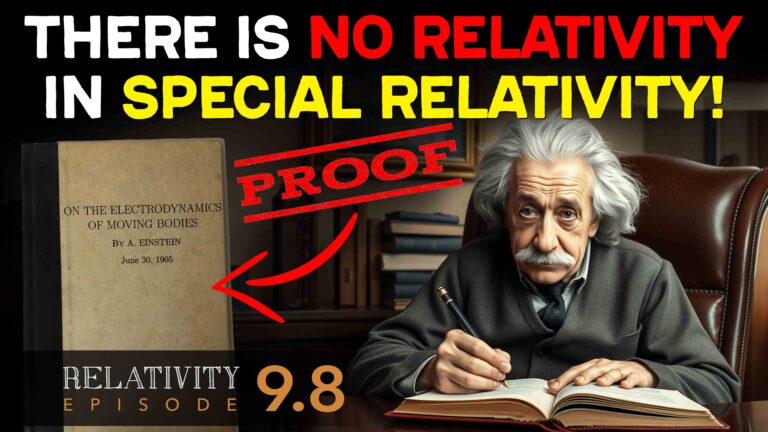Hey, I’m Joe Sorge, and this is Ask Us Whatever. Today we’ve tackled foreign trade. You know that game where foreigners sell us crap that we don’t really need in exchange for money we don’t really have (like when you went on that trip to Florida and bought that flamingo plunger for your bathroom on credit).

Foreign trade is like a Black Mirror episode where everyone is living in a fantasy video game, but then they wake up and realize they weren’t dreaming; and their overconfident political leaders have the game controllers and they’re about to take them into the dungeon of economic doom. Sound overly dramatic? Well, let’s look at President Trump’s tariff strategy.

He’s like a nightclub owner who realizes that women are coming into his nightclub but not buying as much alcohol as men. So, he decides to raise the cover charge for women and make up the difference, and then he tries to figure out why he’s now running a gay men’s club. What I’m saying is that tariffs don’t always produce the desired result, and the law of unexpected consequences usually spoils the party, but the alternative to tariffs (the approach advocated by the vast majority of economists, called “free trade”) also has serious flaws.
Our mission here today is explain why neither approach is ideal and then offer a solution that actually might work. But first I need to cover a little history, and I know history is really boring. In fact, history class is where I caught up on my sleep in the eighth grade so I understand if you’re about to click on another link, but give me a chance because a little bit of history will put this all in perspective. Let’s go back to the 1960s when the United States was the richest country in the world by many fold. We spent money on extravagant things just to show off like sending astronauts to the moon and building monuments for our private parts.

But those excesses in the 60s led to apathy in the 70s. Take our Big Three automakers, for example. They became the poster children for American overconfidence. They began to build pieces of junk like the Pinto and the El Dorado and the Volare. And while their executives were out driving golf balls instead of cars, the powerful United Auto Workers Union negotiated contracts that prohibited their members from being fired even if they came to work drunk or high. American companies and their workers unions were too busy looking up their own assholes to see what was going on in the world. When gasoline prices tripled in the 70s, Americans had to make a choice: spend their money on gasoline and their Saturdays at auto parts stores or buy more reliable fuel-efficient cars. And that’s when the Japanese invaded for the second time. People began to use the name Corolla to describe a car instead of an Italian plumber.


You know, before 1975 we sold more to the rest of the world than we bought, and the technical name for that is a “trade surplus”. But as the quality of our products dropped, American product sales suffered, and we began to operate at what’s called a “trade deficit,” which means we bought more farm products than we sold. In 2006 alone, our trade deficit was eight hundred billion dollars. With that much money you could buy Google or maybe ExxonMobil and McDonald’s…all three billion hamburgers! And that’s how much wealth we lost as a nation in one year.
Now if you keep track of all of our surpluses and deficits over time you get what’s called “the balance of trade,” which for the United States today is also called negative ten trillion dollars. That’s how much wealth we’ve lost to foreign countries in the last 40 years and most of it since the year 2000.
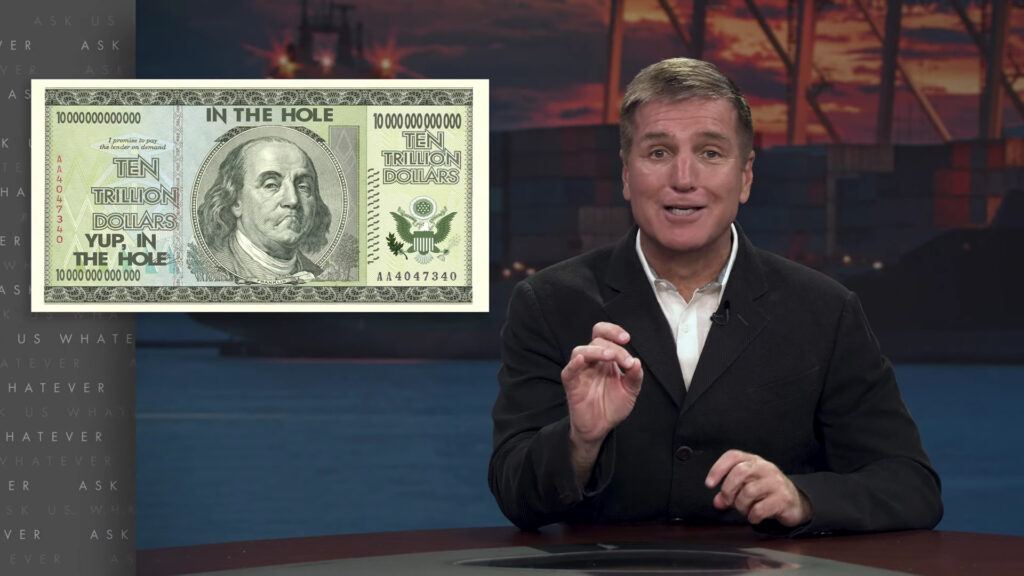
Ten trillion dollars is an enormous amount of wealth. With ten trillion dollars you could buy Switzerland, the country. Oh, and South America, the continent—you could buy their banks, their land, their houses, every street light, crucifix, g-string and cocoa plant. And if that doesn’t scare you then perhaps you could think about it in these terms. With ten trillion dollars you could buy 200 aircraft carriers and ten thousand fighter jets and two hundred thousand tanks and 2 million cruise missiles, and then, in addition to enough firepower to split the planet in half, you could fund active forces the size of the US military 24/7 365 with the amount of wealth we continue losing to foreign countries each year.
So put that in your Kim Jong bong and smoke it.
Some people say well we got things for that 10 trillion dollars. Let’s listen to one of them. When we have a trade deficit, we don’t lose money. It’s not a big pile of cash that we handed over. We bought things that we received. Yes we did receive things with that money, and John is fair to point out that not everything we purchased was all that valuable; and I’m not saying that it was all valuable. Does anyone really need the pony up daddy saddle which allows your child to symbolize their newfound dominance over your life? No! No, I didn’t need it, but I wanted it; and honestly it’s brought my dad and me closer together.
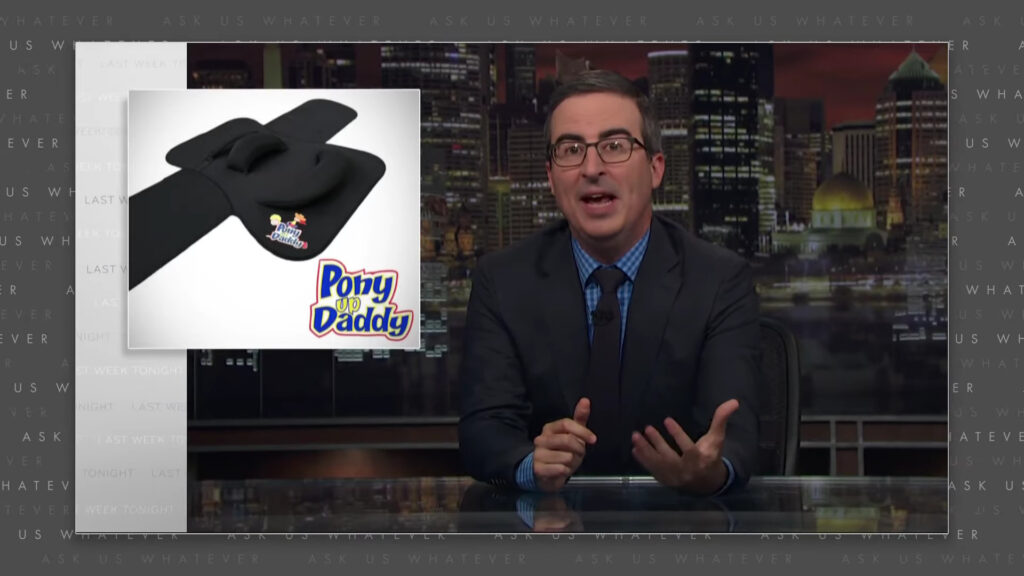
Now, if my goal were merely to make you laugh, well, A) I’d fail miserably, and B) you might get the impression that aside from the pony up daddy saddle, we might have purchased a lot of valuable foreign goods, but let’s think about what we really bought: electronic gadgets, fashion wear, appliances…economists call these products consumables not because we eat them but because they wear out or break or become obsolete or we just don’t love them anymore. And you know what we do with our consumables after we finish with them? We build bird sanctuaries with them and ski slopes and rivers of rubber. Essentially we export trillions of dollars, which can be used to buy anything some dictator’s wicked heart desires, such as weapons or even strategically located US real estate, in exchange for landfills and junkyards full of outdated crap.
That’s not free trade—that’s economic gluttony. So how did we pay for that crap? I mean ten trillion dollars is a lot of money, even for the United States. Where did we get that money? From under our mattresses?
Well, it might seem a little coincidental, but the U.S. currently owes about eleven trillion dollars to foreigners. In other words, they’ve been lending the money we’ve spent back to us, so that we can take advantage of free trade to buy more and more of their junk.
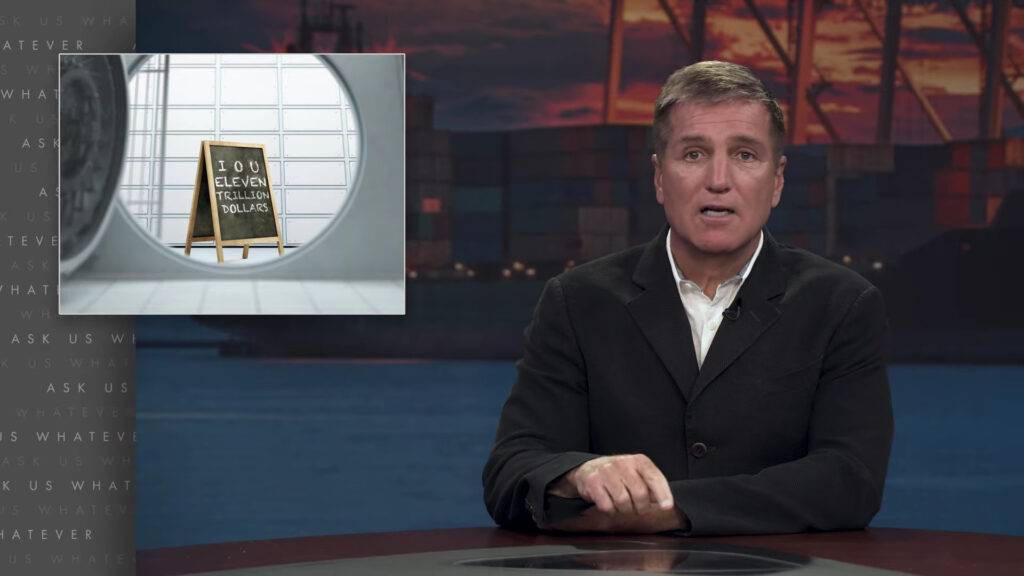
It’s like a loan shark encouraging us to borrow more and more so we can keep placing football bets with his bookie cousin Tony. And you know how that story ends up with a couple of broken knees and some knee replacements. So then why have economists been in favor of unregulated free trade? It’s because on paper free trade, if done right, is good for everyone. Economists generally follow the theory of comparative advantage, which says that we should specialize in making what we’re best at and then trade with others who make what they’re best at, even if we’re better at making everything ourselves. And that’s because there’s just not enough time in the day to make everything ourselves. So everyone benefits by trading their best with each other. And that’s how it works in the textbooks, but problems arise when one country evolves to become better at something that another country used to do.
Free trade unfortunately can cause people to lose their jobs and this is where President Trump has tapped into a gold mine—or let’s say a coal mine—of political support. He’s promised that by jacking up tariffs. He’ll protect American jobs, and he might for a short period of time.

But in 1929, when the U.S. stock market crashed and unemployment began to rise, two Congressmen, Smoot and Hawley, proved that you could look stupid with or without a mustache. Ah, if those were their only shortcomings. These congressmen tried to bring jobs back to America by imposing high tariffs. You know, a tariff, if applied fairly, is supposed to level the playing field so the goods made outside the country cost about the same as goods made domestically; but balancing tariffs is tricky. Set them too high and products become too expensive and people stopped buying. Set them too low and foreign countries eat our lunch.
Smoot and Hawley jacked up tariff rates way too high, way too fast and the plan backfired. Imports became expensive people bought less. Retailers and apartment stores closed and jobs disappeared. And what’s worse, foreign countries retaliated and raised their tariff rates too, which by the way is exactly what China’s doing now in response to President Trump’s tariffs. Let’s hope it doesn’t escalate any further because in 1929 the retaliation rose to the point where foreign buyers could no longer afford our products and that knockout punch to our economy led us into the Great Depression of the 1930s, with 25% unemployment, soup and bread lines around the block, and massive homelessness.
Smoot and Hawley’s plan to protect American jobs was a complete failure that thrust millions of Americans into poverty. It took 15 years for the U.S. to dig its way out of that disaster, so hopefully someone at Fox News will open up a history book and do a segment on Smoot and Hawley—and hopefully someone else will watch it.
Alright, what’s the solution? Can trade be regulated in a way that prevents large amounts of wealth and jobs from leaving the country without kicking comparative advantage to the curb? You know, our country took baby steps in that direction in the 1950s by joining an organization that eventually became the World Trade Organization or WTO. The intent of the WTO was to provide a forum in which countries could negotiate fair and reasonable tariff rates, and it improved trade for a while, but things change over time.

Government’s rise and fall; new technologies displace old technologies; and communists eventually start behaving like capitalists. I mean just take a look at that photo. They’re all wearing red ties like someone else we know.
Anyway, with all these enormous changes around the world you have to adjust tariff rates in real time to adapt. Unfortunately, like most political organizations, the WTO has become bogged down in competing interests and petty squabbles. And so they’ve not been able to reach a new trade agreement in 25 years. A lot can change in 25 years. Frankly a lot can change in a year or a month, and so the idea of letting a UN-like body of bureaucrats set tariff rates on thousands of products, trade it between hundreds of countries, would be like letting Mitch McConnell fly the Millennium Falcon.
I have a better idea, or at least I think.

Let’s modernize the whole process and create something like an electronic stock market for tariff rates. In other words, instead of letting bureaucrats and politicians set tariff rates, let’s allow supply and demand to do it. I’ve devised a system that I call a “multiplexed closest pair auction”. You know, it’s nothing more than deploying cluster analysis and eigenvector sorting to create a multiplexed heads up algorithm.
Sorry I just had to do that. Let’s just call it the economic equivalent of the first stage in March Madness, where importers competed auction to win import licenses. Most people think of an auction is having one winner pays the highest price for a limited supply of something, but there are other types of auctions. For example, flowers are often sold at what’s called a Dutch auction where the asking price declines until someone bids and if the first bidder doesn’t purchase the entire lot other bidders can purchase the remaining portions at lower and lower prices. A multiplexed closest pair auction is something like a Dutch auction but with paired bidding between importers with similar price brackets.
I’ve created a white paper that describes it and for the two of you who might like a copy, here’s a link.
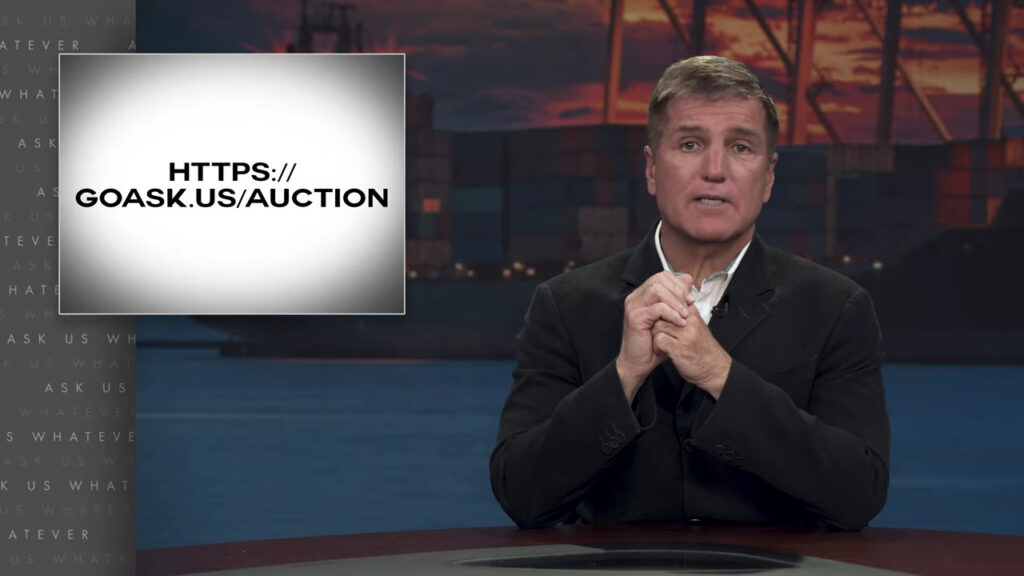
Now, some economists might argue that any new tariffs whether set by government or by auction will cause prices to go up. That’s not necessarily the case because the auction model that I’m proposing will promote a kind of competition that will keep prices in check. It’s essentially a way to motivate foreign producers to give back a portion of that very profitable trade surplus to stay in the game, because if they don’t they’re competitors will. Other economists might argue that floating currency exchange rates already act something like an auction process that eventually neutralizes trade imbalances, but governments can and do manipulate their currencies. And if you’re looking for proof that floating currency exchange rates don’t always float and if not resolve trade imbalances, just take another look down the 10 trillion dollar hole that we’ve been digging for the last 44 years.
If all countries would use closest pair options, market forces would balance trade automatically and would eliminate the urge to enact trade barriers and for the U.S. that would direct half a trillion dollars a year back to the US Treasury. So, instead of having to borrow our own dollars from foreign nations and pay them back with our grandchildren’s future earnings, we would automatically recapture those dollars.
And if we’re smart we’ll invest them in worker retraining in industries where we either have or should develop a comparative advantage. Because if we want to keep America great, we need to create the future, not just watch it happen.

Okay, that’s it for now. If you have any questions ask us whatever in the comments section. I’m Joe Sorge, and thanks for watching.



